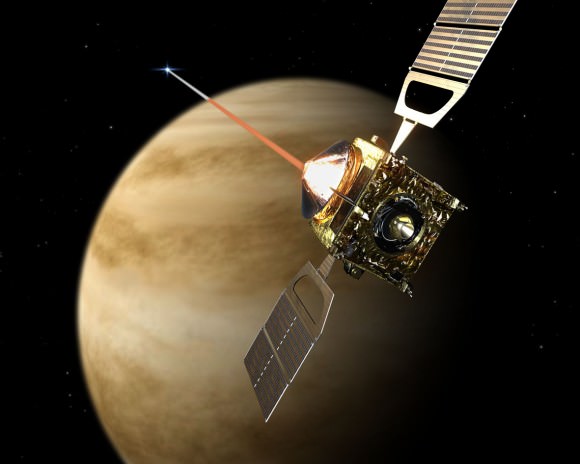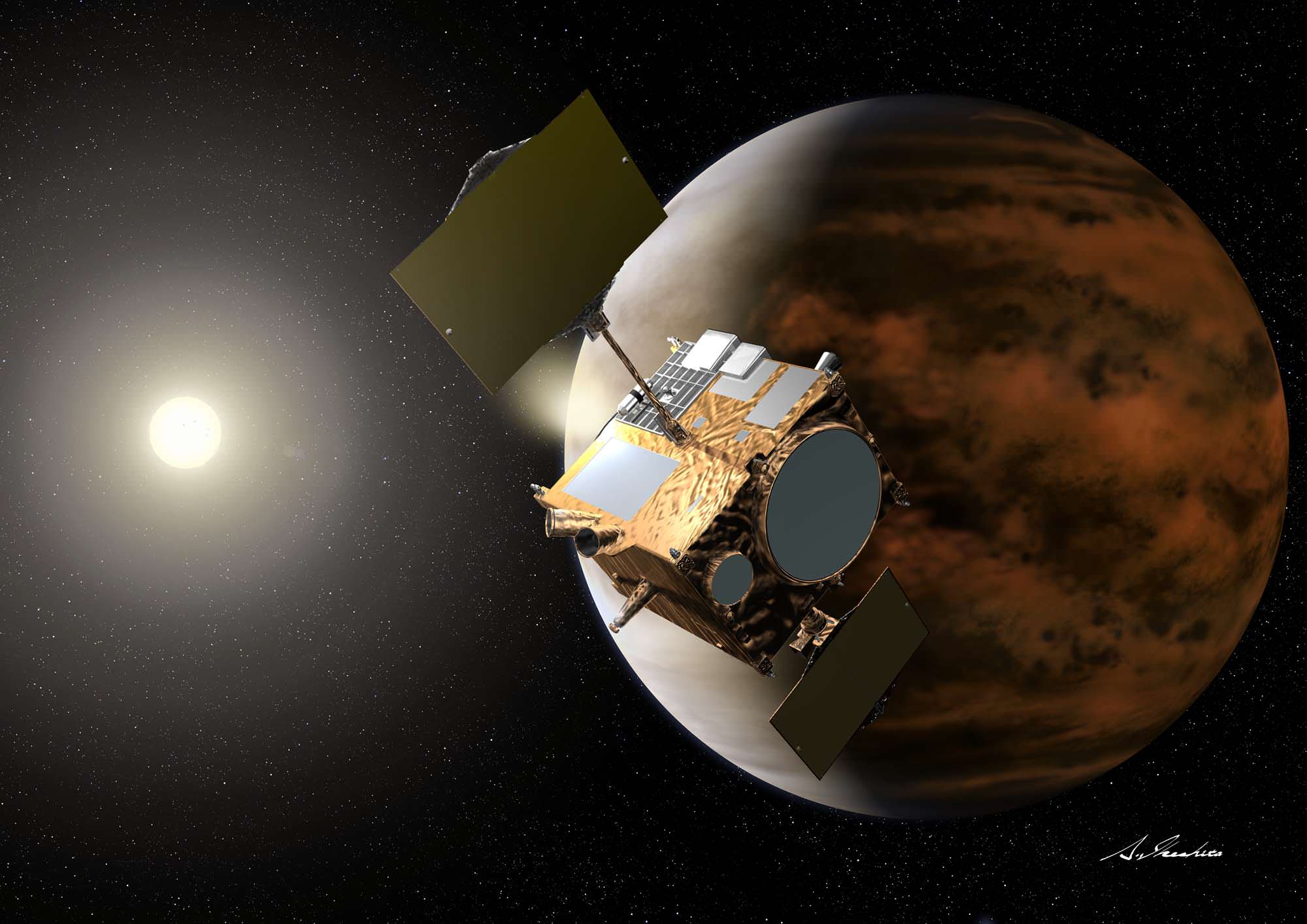Back in 2010, the Japanese Aerospace Exploration Agency (JAXA) launched the The Venus Climate Orbiter “Akatsuki” with the intention of learning more about the planet’s weather and surface conditions. Unfortunately, due to engine trouble, the probe failed to make it into the planet’s orbit.
Since that time, it has remained in a heliocentric orbit, some 134 million kilometers from Venus, conducting scientific studies on the solar wind. However, JAXA is going to make one more attempt to slip the probe into Venus’ orbit before its fuel runs out.
Since 2010, JAXA has been working to keep Akatsuki functioning so that they could give the spacecraft another try at entering Venus’ orbit.
After a thorough examination of all the possibilities for the failure, JAXA determined that the probe’s main engine burned out as it attempted to decelerate on approach to the planet. They claim this was likely due to a malfunctioning valve in the spacecraft’s fuel pressure system caused by salt deposits jamming the valve between the helium pressurization tank and the fuel tank. This resulted in high temperatures that damaged the engine’s combustion chamber throat and nozzle.

JAXA adjusted the spacecraft’s orbit so that it would establish a heliocentric orbit, with the hopes that it would be able to swing by Venus again in the future. Initially, the plan was to make another orbit insertion attempt by the end 2016 when the spacecraft’s orbit would bring it back to Venus. But because the spacecraft’s speed has slowed more than expected, JAXA determined if they slowly decelerated Akatsuki even more, Venus would “catch up with it” even sooner. A quicker return to Venus would also be advantageous in terms of the lifespan of the spacecraft and its equipment.
But this second chance will likely be the final chance, depending on how much damage there is to the engines and other systems. The reasons for making this final attempt are quite obvious. In addition to providing vital information on Venus’ meteorological phenomena and surface conditions, the successful orbital insertion of Akatsuki would also be the first time that Japan deployed a satellite around a planet other than Earth.
If all goes well, Akatsuki will enter orbit around Venus at a distance of roughly 300,000 to 400,000 km from the surface, using the probe’s 12 smaller engines since the main engine remains non-functional. The original mission called for the probe to establish an elliptical orbit that would place it 300 to 80,000 km away from Venus’ surface.
This wide variation in distance was intended to provide the chance to study the planet’s meteorological phenomena and its surface in detail, while still being able to observe atmospheric particles escaping into space.

At a distance of 400,000 km, the image quality and opportunities to capture them are expected to be diminished. However, JAXA is still confident that it will be able to accomplish most of the mission’s scientific goals.
In its original form, these goals included obtaining meteorological information on Venus using four cameras that capture images in the ultraviolet and infrared wavelengths. These would be responsible for globally mapping clouds and peering beneath the veil of the planet’s thick atmosphere.
Lightning would be detected with a high-speed imager, and radio-science monitors would observe the vertical structure of the atmosphere. In so doing, JAXA hopes to confirm the existence of surface volcanoes and lighting, both of which were first detected by the ESA’s Venus Express spacecraft. One of the original aims of Akatsuki was to complement the Venus Express mission. But Venus Express has now completed its mission, running out of gas and plunging into the planet’s atmosphere.
But most of all, it is hoped that Akatsuki can provide observational data on the greatest mystery of Venus, which has to do with its surface storms.

Previous observations of the planet have shown that winds that can reach up to 100 m/s (360 km/h or ~225 mph) circle the planet every four to five Earth days. This means that Venus experiences winds that are up to 60 times faster than the speed at which the planet turns, a phenomena known as “Super-rotation”.
Here on Earth, the fastest winds are only capable of reaching between 10 and 20 percent of the planet’s rotation. As such, our current meteorological understanding does not account for these super-high speed winds, and it is hoped that more information on the atmosphere will provide some clues as to how this can happen.
Between the extremely thick clouds, sulfuric rain storms, lightning, and high-speed winds, Venus’ atmosphere is certainly very interesting! Add to the fact that the volcanic, pockmarked surface cannot be surveyed without the help of sophisticated radar or IR imaging, and you begin to understand why JAXA is eager to get their probe into orbit while they still can.
And be sure to check out this video, courtesy of JAXA, detailing the Venus Climate Orbiter mission:
Further Reading: JAXA


The curse of automated spell-checkers seems to be at work here. Did you not mean to write ‘lightning’ instead of lighting?
Thanks for the catch – this spell-check “typo” has been fixed!
Good luck JAXA!
….and the proper spelling in the context you have is “complement” and NOT “compliment”……………Sorry, I hate to nitpick; great article!
Corrected! 😉